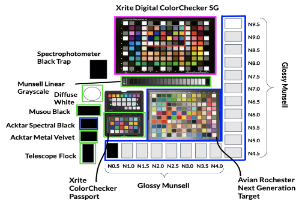
Accurate representation of diverse skin tones in photography has been a longstanding challenge due to biases toward lighter skin in traditional reference materials used for film and digital photography, such as Kodak’s “Shirley” cards and the Fitzpatrick scale. These and other tools, such as the ColorChecker Classic, have offered limited ranges of skin tones and do not capture the full diversity of human skin, including variations in shades, undertones, and exposure behavior. In this study, we evaluate the application of the 10-point Monk Skin Tone Scale, developed by Harvard’s Dr. Ellis Monk, to camera testing and characterization using printed skin tone charts. The Monk scale is applied to color-matched printed faces for testing cameras with facial detection capabilities. We compare the measured CIELAB values and reflectance spectra of these printed targets to those of other commonly used skin tone references, and to data measured from real human skin. Additionally, we assess the performance of these printed targets in photographed scenes in terms of exposure accuracy and color reproduction. This research identifies limitations and strengths of current printed skin tone scales and charts in representing actual human skin tones, and introduces a novel solution for improving equitable camera calibration and characterization protocols.

The capability for a camera to produce a color-accurate high dynamic range image is based upon its capture of luminance within a scene as well as the targets chosen to create the color transformation matrix. The wide-ranging luminance within a scene is an important part of cultural heritage documentation to appropriately capture an object's appearance. In addition, color accuracy is critical to documenting cultural heritage appropriately. This research compares prosumer and mobile phone cameras for cultural heritage documentation using single exposure and high dynamic range images. It focuses on the evaluation of color characterization process, color reproduction quality, and generation of the scene. This was done by using two types of prosumer cameras and two types of mobile phone cameras, at 800 lux with a wide range of color targets with various surface textures, matte, semigloss, and glossy. It was found that for creating color calibration matrices, a single exposure outperformed the one created from fusion of multiple exposure images. Additionally, including an extended achromatic scale along with the traditional Macbeth colors as part of the training data for the color calibration matrix may increase color accuracy for different cameras and the samples in the scene.

The color accuracy of an LED-based multispectral imaging strategy has been evaluated with respect to the number of spectral bands used to build a color profile and render the final image. Images were captured under select illumination conditions provided by 10-channel LED light sources. First, the imaging system was characterized in its full 10-band capacity, in which an image was captured under illumination by each of the 10 LEDs in turn, and the full set used to derive a system profile. Then, the system was characterized in increasingly reduced capacities, obtained by reducing the number of bands in two ways. In one approach, image bands were systematically removed from the full 10-band set. In the other, images were captured under illumination by groups of several of the LEDs at once. For both approaches, the system was characterized using different combinations of image bands until the optimal set, giving the highest color accuracy, was determined when a total of only 9, 8, 7, or 6 bands was used to derive the profile. The results indicate that color accuracy is nearly equivalent when rendering images based on the optimal combination of anywhere from 6 to 10 spectral bands, and is maintained at a higher level than that of conventional RGB imaging. This information is a first step toward informing the development of practical LED-based multispectral imaging strategies that make spectral image capture simpler and more efficient for heritage digitization workflows.